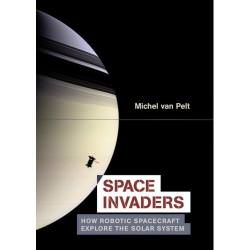Robots are our autonomous surrogates. They faithfully travel wherever we fear to tread. Michel van Pelt in his book, Space Invaders – How Robotic Spacecraft Explore the Solar System provides a practical look at these amazing machines that travel ever further from our home base on Earth. Though they get shaked, baked and rattled, they are the champions for long distance, harsh environment exploration.
Mechanical instruments and sensors duplicate and extend many of our abilities. For instance, their artificial eyes detect electromagnetic energy at frequencies will outside the visible spectrum. With a broad suite of such sensors, a machine can directly measure planetary magnetic fields and atmospheric composition and beam results back to Earth for further analysis. Coupling this with the ability to repeat endlessly and without complaints makes these mechanical marvels superbly suited for their task. With them extending our awareness ever further off Earth, we’re knowing more and more of the surrounding universe.
Michel van Pelt’s book treats these space borne proteges with care and attention. Two main themes are present. One follows the system design elements that typically constrain the complex space robots. The other is a description of the particular missions that they’ve completed, together with a brief description of their findings. Design work includes power supplies, Hoffman transfer routes, and transiting over rough ground. And, as with all such considerations, there’s much ado in the book about cost and schedule for the robot programs. Luckily, there seems to be no shortage of people who want to get and use results, so at least that part of the program management doesn’t need as much attention.
Understandably, our robotic servants do complex work that’s based on elementary physics. However, van Pelt’s book keeps well away from these esoteric niceties and remains with generalities. At times it dips into exotics, such as hypothesising how to travel in highly acidic pools on planets with variable gravity. But these serve to show the challenges and necessary flexibility in robotic design. As well, with a writing date of early 2006, it contains many current references, including Venus Express and the Mars Landers. From it, the reader can well appreciate the effort that goes into ensuring that robots can acquire the most useful information.
van Pelt enhances this distillation by using a simple writing style with little specialized nomenclature. Thus, the book is well suited to youths, young adults and those with a general interest. Yet, the content isn’t trite as it deals with some of the most amazing discoveries made by our species. In recognition of this, van Pelt adds a fair amount of description of these discoveries; major surface features, ring structures and asteroid composition. With this, the reader will be left with no doubt about the capability and utility of our little mechanical assistants.
This book’s weakness, however, is its lack of a solid appraisal of machines. Around us, a current, active debate tries to establish the value of human crewed space exploration versus an outreach based purely on machines. There’s no reference to this in the book. It mentions the Apollo missions and the many robot successes but not as to which is better or what would be most rewarding in the future. This weakness leads into a second one. The book doesn’t consider the immediate future of space robotics. It skips from today’s probes and jumps to a future where squadrons of miniature flying sensors scour foreign climates. Hence, the reader is left staring off a cliff of success into a sea of uncertainty regarding the robots.
We are invading space with our machines. Their sensors give us first hand accounts of places we can only dream of visiting. Michel van Pelt in his book , Space Invaders – How Robotic Spacecraft Explore the Solar System provides us with the design methodology of these machines, together with some of their discoveries. It shows the success of our invasion throughout the solar system.

